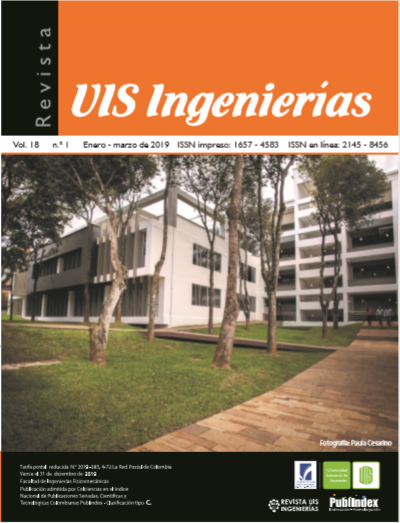Tortuosity and permeability of mesoporous ceramics of kaolin and diatomite
Published 2019-01-01
Keywords
- form factor,
- tortuosity,
- permeability,
- electrical resistivity,
- mesoporous ceramics
How to Cite
Abstract
In this paper, the permeability and tortuosity of mesoporous ceramics of kaolin and diatomite are reported. The cylindrical samples with weight percentages of 60% diatomite, 30% kaolin and 10% CaCO3 were made by casting, with an average diameter of 5 cm and a thickness of 0.6 cm. The drying process was carried out through the forced circulation stove at 100 °C for 24 hours and the sintering at temperatures of 800 °C, 850 °C, 900 °C, 950 °C, 1000 °C and 1100 °C, using an electric muffle with a ramp of 5 °C/min. For the determination of water permeability, a variable load permeameter was used, while the tortuosity was found from the product of the form factor and its porosity. The results of tortuosity were found in the range of 3.32 to 7.16, whereas permeability varied between 3.09x10-6 and 22.2x10-6 cm/s, evidencing an inverse behavior between these parameters when increasing to temperature.
Downloads
References
R. Roque Malherbe, W. del Valle, F. Marquez, J. Duconge y M. Goosen, “Synthesis and Characterization of Zeolite Based Porous Ceramic Membranes,” Sep. Sci. Technol., vol. 41, núm. 1, pp. 73–96, ene. 2006. doi: 10.1080/01496390500446277
A. Merioua, A. Bezzar y F. Ghomari, “Electrical prediction of tortuosity in porous media,” Energy Procedia, vol. 139, pp. 718-724, 2017. doi: 10.1016/j.egypro.2017.11.277
H. Saomoto y J. Katagiri, “Direct comparison of hydraulic tortuosity and electric tortuosity based on finite element analysis,” Theoretical and Applied Mechanics Letters, vol. 5, no. 5pp. 177-180, 2015. doi: 10.1016/j.taml.2015.07.001
K. K. Imomnazarov, “Archie’s Law for a Mathematical Model of Movement of a Conducting Liquid through a Conducting Porous Medium,” Applied Mathematics Letters, vol. 11, no. 6, pp. 135-138, 1998. doi: 10.1016/S0893-9659(98)00115-3
L. Simao, O. R. Klegues Montedo, M. M. da Silva Paula, L. da Silva, R. Caldato y M. D. de Mello Innocentini, “Structural and Fluid Dynamic Characterization of Calcium Carbonate-based Porous Ceramics,” Materials Research, vol. 16, no. 4, pp. 1439-1448, 2013. doi: 10.1590/S1516-14392013005000147
E. A. Moreira y J. R. Coury, “The influence of structural parameters on the permeability of ceramic foams,” Brazilian Journal of Chemical Engineering, vol. 21, no. 01, pp. 23-33, 2004. doi: 10.1590/S0104-66322004000100004
M. Barrande, R. Bouchet y R. Denoyel, “Tortuosity of Porous Particles,” Analytical chemistry, vol. 79, no. 23, pp. 9115-9121, 2007. doi: 10.1021/ac071377r
A. Eshghinejadfard, L. Daroczy, G. Janiga y D. Thevenin, “Calculation of the permeability in porous media using the lattice Boltzmann method,” International Journal of Heat and Fluid Flow, pp. 1-11, 2016. doi: 10.1016/j.ijheatfluidflow.2016.05.010
Z. Sun, X. Tang y G. Cheng, “Numerical simulation for tortuosity of porous media,”Microporous and Mesoporous Materials, vol. 173, pp. 37-42, 2013. doi: 10.1016/j.micromeso.2013.01.035
E. Garcia, I. Amaya y R. Correa, “Algoritmos de optimización en la estimación de propiedades termodinámicas en tiempo real durante el tratamiento térmico de materiales con microondas,” Rev. Uis Ing., vol. 16, no. 2, pp. 129-140, 2017. doi: 10.18273/revuin.v16n2-2017012
Z. Hu y K. Lu, “Evolution of Pores and Tortuosity During Sintering,” J. Am. Ceram. Soc., vol. 97, no. 8, pp. 2383-2386, 2014. doi: 10.1111/jace.13080
P. M. Biesheuvel y H. Verweij, “Design of ceramic membrane supports: permeability, tensile strength and stress,” Journal of Membrane Science, vol. 156, no. 1, pp. 141-152, 1999. doi: 10.1016/S0376-7388(98)00335-4
A. Dey, N. Kayal, O. Chakrabarti, R. Caldato, C. André y M. Innocentini, “Permeability and Nanoparticle Filtration Assessment of Cordierite-Bonded Porous SiC Ceramics,” Ind. Eng. Chem. Res., vol. 52, no. 51, pp. 18362-18372, 2013. Doi: 10.1021/ie402876v
M. París de Ferrer, Fundamentos de Ingeniería de Yacimientos. Maracaibo, Venezuela: Astro Data, 2009.
Métodos de ensayo para productos refractarios conformados densos. Parte 1: Determinación de la densidad aparente, de la porosidad abierta y de la porosidad total, UNE-EN 993-1, 1996.
A. E. Sheidegger, “Immiscible Multiple Phase Flow”, en The Physics of Flow Through Porous Media, 3^ra ed. Toronto, Canadá: University of Toronto Press, 1974, cap. 9, pp. 215-255.
B. Ghanbarian, A. G. Hunt, R. P. Ewing, y M. Sahimi, “Tortuosity in Porous Media: A Critical Review,” Soil Sci. Soc. Am. J., vol. 77, no. 5, pp. 1461-1477, 2013. doi: 10.2136/sssaj2012.0435
E. A. Moreira, M. D. M. Innocentini, y J. R. Coury, “Permeability of ceramic foams to compressible and incompressible flow,” J. Eur. Cer. Soc., vol. 24, no. 10-11, pp. 3209-3218, 2004. doi: 10.1016/j.jeurceramsoc.2003.11.014
M. R. Malcolm, "The Theory of Quantitative Log Interpretation", en The Fundamentals of Electric Log Interpretation, 2^da ed. New York, USA: Academic Press INC, 1957, pt. 1, pp. 1-19.
F. A. Dullien, "Single-Phase Transport Phenomena in Porous Media", en Porous Media: Fluid transport and pore structure, 1^ra ed. Londres, Inglaterra: Academic Press, 1979, cap. 4, pp. 157-230.
J. Cembrero, C. Ferrer, M. Pascual y M. Á. Pérez, Ciencia y tecnología de materiales - Problemas y cuestiones, 1^ra ed. Madrid, España: Pearson - Prentice Hall, 2005.
D. W. Taylor, “Permeabilidad”, en Principios fundamentales de mecánica de suelos, 1^ra ed. D.F, México: Continental S.A, 1961, cap. 6, pp. 119-147.
B. M. Das, "Conductividad Hidráulica", en Fundamentos de ingeniería geotécnica, 4^ta ed. Santa Fe, México: Cengage Learning, 2015, cap. 6, pp. 116-141.
D. Graux, “Permeabilidad y caudal”, en Fundamentos de Mecánica del Suelo, proyecto de muros y cimentaciones, 2^da ed. Barcelona, España: Editores Técnicos Asociados, S.A, 1975, cap. 14, pp. 355-404.
G. S. Armatas, C. E. Salmas, G. P. Androutsopoulos, and P. J. Pomonis, “The effect of surface functionalization of mesoporous silicas with propylimidazol on porosity, pore connectivity and tortuosity,” Stud. Surf. Sci. Catal, vol. 144, pp. 299-306, 2002. doi: 10.1016/S0167-2991(02)80148-3
S. Kam et al., “Permeability to water of sintered clay ceramics”, Appl. Clay Sci., vol. 46, no. 4, pp. 351–357, 2009. doi: 10.1016/j.clay.2009.09.005

